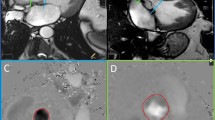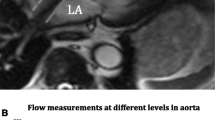Abstract
Objectives
Compare variability in flow measurements by phase contrast MRI, performed at different locations in the aorta and pulmonary artery (PA) using breath-held (BH) and free-breathing (FB) sequences.
Methods
Fifty-seven patients with valvular heart disease, confirmed by echocardiography, were scanned using BH technique at 3 locations in the ascending aorta (SOV = sinus of Valsalva, STJ = sinotubular junction, ASC = ascending aorta at level of right pulmonary artery) and 2 locations in PA. Single FB measurement was obtained at STJ for aorta. Obtained metrics (SV = stroke volume, FV = forward volume, BV = backward volume, RF = regurgitant fraction) were evaluated separately for patients with aortic regurgitation (AR, n = 31) and mitral regurgitation (n = 26).
Results
No difference was noted between the two measurements in the PA. Significant differences were noted in measured SV at different aortic locations. SV measurements obtained at ASC correlated best with the measurements obtained in the PA. Strongest correlation of AR was measured at the STJ.
Conclusion
Measurements of flow volumes by phase contrast MRI differ depending on slice location. When using stroke volumes to calculate pulmonary to systemic blood flow ratio (Qp/Qs), ASC should be used. For quantifying aortic regurgitation, measurement should be obtained at STJ.
Key Points
• Aortic regurgitation can be accurately measured by MRI.
• Aortic regurgitation measurement by MRI varies according to the location where measured.
• Aortic regurgitation can also be measured by MRI without breath hold.







Similar content being viewed by others
References
Kramer CM (ed) (2010) Multimodality imaging in cardiovascular medicine. Demos Medical, New York
Kutty S, Whitehead KK, Natarajan S, Harris MA, Wernovsky G, Fogel MA (2009) Qualitative echocardiographic assessment of aortic valve regurgitation with quantitative cardiac magnetic resonance: a comparative study. Pediatr Cardiol 30:971–977
Cawley PJ, Otto CM (2009) Valvular regurgitation: does cardiovascular magnetic resonance provide additional information compared to echocardiography? Minerva Cardioangiol 57:521–535
Kozerke S, Scheidegger MB, Pedersen EM, Boesiger P (1999) Heart motion adapted cine phase-contrast flow measurements through the aortic valve. Magn Reson Med 42:970–978
Cawley PJ, Hamilton-Craig C, Owens DS et al (2013) Prospective comparison of valve regurgitation quantitation by cardiac magnetic resonance imaging and transthoracic echocardiography. Circ Cardiovasc Imaging 6:48–57
Myerson SG, d'Arcy J, Mohiaddin R et al (2012) Aortic regurgitation quantification using cardiovascular magnetic resonance: association with clinical outcome. Circulation 126:1452–1460
Chatzimavroudis GP, Walker PG, Oshinski JN, Franch RH, Pettigrew RI, Yoganathan AP (1997) Slice location dependence of aortic regurgitation measurements with MR phase velocity mapping. Magn Reson Med 37:545–551
Devos DG, Kilner PJ (2010) Calculations of cardiovascular shunts and regurgitation using magnetic resonance ventricular volume and aortic and pulmonary flow measurements. Eur Radiol 20:410–421
Pouleur AC, le Polain de Waroux JB, Goffinet C et al (2008) Accuracy of the flow convergence method for quantification of aortic regurgitation in patients with central versus eccentric jets. Am J Cardiol 102:475–480
Bogren HG, Buonocore MH (1999) Complex flow patterns in the great vessels: a review. Int J Card Imaging 15:105–113
Honda N, Machida K, Hashimoto M et al (1993) Aortic regurgitation: quantitation with MR imaging velocity mapping. Radiology 186:189–194
Kilner PJ, Gatehouse PD, Firmin DN (2007) Flow measurement by magnetic resonance: a unique asset worth optimising. J Cardiovasc Magn Reson 9:723–728
Laffon E, Galy-Lacour C, Laurent F, Ducassou D, Marthan R (2003) MRI quantification of the role of the reflected pressure wave on coronary and ascending aortic blood flow. Physiol Meas 24:681–692
Wittlinger T, Dzemali O, Bakhtiary F, Moritz A, Kleine P (2008) Hemodynamic evaluation of aortic regurgitation by magnetic resonance imaging. Asian Cardiovasc Thorac Ann 16:278–283
Baltes C, Hansen MS, Tsao J et al (2008) Determination of peak velocity in stenotic areas: echocardiography versus k-t SENSE accelerated MR Fourier velocity encoding. Radiology 246:249–257
Bonow RO, Carabello BA, Chatterjee K et al (2006) ACC/AHA 2006 guidelines for the management of patients with valvular heart disease: a report of the American College of Cardiology/American Heart Association Task Force on Practice Guidelines (writing committee to revise the 1998 guidelines for the management of patients with valvular heart disease) developed in collaboration with the Society of Cardiovascular Anesthesiologists endorsed by the Society for Cardiovascular Angiography and Interventions and the Society of Thoracic Surgeons. J Am Coll Cardiol 48:e1–148
Shin HJ, Shin JK, Chee HK, Kim JS, Ko SM (2015) Characteristics of aortic valve dysfunction and ascending aorta dimensions according to bicuspid aortic valve morphology. Eur Radiol 25:2103–2114
Detaint D, Messika-Zeitoun D, Maalouf J et al (2008) Quantitative echocardiographic determinants of clinical outcome in asymptomatic patients with aortic regurgitation: a prospective study. JACC Cardiovasc Imaging 1:1–11
Croft CH, Lipscomb K, Mathis K et al (1984) Limitations of qualitative angiographic grading in aortic or mitral regurgitation. Am J Cardiol 53:1593–1598
Dahiya A, Bolen M, Grimm RA, Rodriguez LL, Thomas JD, Marwick TH (2012) Development of a consensus document to improve multireader concordance and accuracy of aortic regurgitation severity grading by echocardiography versus cardiac magnetic resonance imaging. Am J Cardiol 110:709–714
Goffinet C, Kersten V, Pouleur AC et al (2010) Comprehensive assessment of the severity and mechanism of aortic regurgitation using multidetector CT and MR. Eur Radiol 20:326–336
Sakuma H, Kawada N, Kubo H et al (2001) Effect of breath holding on blood flow measurement using fast velocity encoded cine MRI. Magn Reson Med 45:346–348
Hall JE, Guyton AC (2011) Coronary circulation, Chap. 21. In: Guyton and Hall textbook of medical physiology. Saunders/Elsevier, Philadelphia, pp xix, 1091 p
Reid SA, Walker PG, Fisher J et al (2002) The quantification of pulmonary valve haemodynamics using MRI. Int J Cardiovasc Imaging 18:217–225
Rahman EA, Koshy M, Neill J et al (2014) Quantitation of pulmonary regurgitation in repaired tetralogy of Fallot by cardiac magnetic resonance – it matters where you measure! Global Heart 9:e143–144
Markl M, Frydrychowicz A, Kozerke S, Hope M, Wieben O (2012) 4D flow MRI. J Magn Reson Imaging 36:1015–1036
Gatehouse PD, Rolf MP, Graves MJ et al (2010) Flow measurement by cardiovascular magnetic resonance: a multi-centre multi-vendor study of background phase offset errors that can compromise the accuracy of derived regurgitant or shunt flow measurements. J Cardiovasc Magn Reson 12:5
Acknowledgments
The scientific guarantor of this publication is Jeffery H. Maki. The authors of this manuscript declare relationships with the following companies: none. This study has received funding by research grants from the Society for Cardiovascular Angiography and Interventions, General Electric, and the John L. Locke Jr. Charitable Trust. Dr. Christian H. Craig was supported by the Smart Futures Fellowship early career grant and the Washington-Queensland Trans-Pacific Fellowship Trust. Timothy M. Baran kindly provided statistical advice for this manuscript. Institutional review board approval was obtained. Written informed consent was obtained from all subjects (patients) in this study. Some study subjects or cohorts have been previously reported (Circ Cardiovasc Imaging 6:48–57, 2003). Methodology: prospective, observational, performed at one institution.
Author information
Authors and Affiliations
Corresponding author
Rights and permissions
About this article
Cite this article
Chaturvedi, A., Hamilton-Craig, C., Cawley, P.J. et al. Quantitating aortic regurgitation by cardiovascular magnetic resonance: significant variations due to slice location and breath holding. Eur Radiol 26, 3180–3189 (2016). https://doi.org/10.1007/s00330-015-4120-6
Received:
Revised:
Accepted:
Published:
Issue Date:
DOI: https://doi.org/10.1007/s00330-015-4120-6




